

TO: Director, National Institute for Occupational Safety and Health
FROM: Iowa Fatality Assessment and Control Evaluation (FACE) Program
DATE: June 2000
SUBJECT: Sanitation assistant crushed between garbage truck and compactor
SUMMARY:
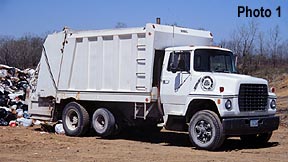 A 30 year-old male
sanitation assistant (the victim) was crushed by the hydraulically
powered tailgate of a garbage truck while unloading garbage at
a county landfill. The truck operator and the victim had just
finished unloading their garbage truck, lowered the tailgate to
the 3/4 closed position and had cleaned the tailgate latching
screws. Before the tailgate was fully lowered, the operator alerted
the victim, by saying "stand clear" and the victim responded
accordingly. The tailgate was then lowered by the operator using
controls on the driver's side of the truck, out of sight from
the victim on the opposite side of the truck. When the operator
walked to the passenger side for a final check, he found the victim
lying on the ground with significant head injuries. His head had
been caught between the frame of the truck and the tailgate as
it was closing. The operator and a bulldozer operator called 911
for assistance. The County Sheriff, his deputy, and ambulance
personnel arrived at the scene within minutes. The county medical
examiner was notified, responded, and pronounced the man dead
at the scene. The truck was found to be in normal operating order.
A discarded fishing pole was found inside the garbage compartment
of the truck, and it is possible that the victim was trying to
retrieve this item immediately prior to getting caught.
A 30 year-old male
sanitation assistant (the victim) was crushed by the hydraulically
powered tailgate of a garbage truck while unloading garbage at
a county landfill. The truck operator and the victim had just
finished unloading their garbage truck, lowered the tailgate to
the 3/4 closed position and had cleaned the tailgate latching
screws. Before the tailgate was fully lowered, the operator alerted
the victim, by saying "stand clear" and the victim responded
accordingly. The tailgate was then lowered by the operator using
controls on the driver's side of the truck, out of sight from
the victim on the opposite side of the truck. When the operator
walked to the passenger side for a final check, he found the victim
lying on the ground with significant head injuries. His head had
been caught between the frame of the truck and the tailgate as
it was closing. The operator and a bulldozer operator called 911
for assistance. The County Sheriff, his deputy, and ambulance
personnel arrived at the scene within minutes. The county medical
examiner was notified, responded, and pronounced the man dead
at the scene. The truck was found to be in normal operating order.
A discarded fishing pole was found inside the garbage compartment
of the truck, and it is possible that the victim was trying to
retrieve this item immediately prior to getting caught.
RECOMMENDATIONS based on our evaluation are as follows:
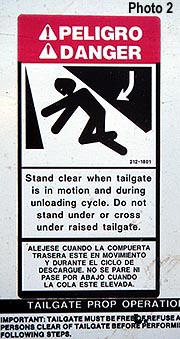 INTRODUCTION
INTRODUCTION
In March 2000, a sanitation assistant (the victim) died after being crushed by a garbage truck compactor at 10:49 am. The Iowa FACE program became aware of the incident two days later through a local radio station news broadcast. A site visit was conducted in April 2000 with FACE personnel and the county sheriff, deputy, and sanitation operator. Photos were taken at the landfill showing the same garbage truck while it was unloading. Information was gathered from the county sheriff, police and medical examiner reports, and the OSHA inspection file.
The owner/operator was self-employed in a small family-owned business, using a typical sanitation truck (gross vehicle weight 40,000 lbs). The sanitation assistant had worked the previous day and about 10 other times in the past three years; he did not have a regular job. The operator usually employed one sanitation assistant, his nephew. On this occasion, the operator employed the victim, the operator's cousin.
INVESTIGATION
A 30-year-old male was crushed between the frame of a garbage truck and the hydraulic compactor after unloading at a landfill site. A warning sign was posted on the passenger's side of the truck stating "Stand clear when tailgate is in motion and during unloading cycle" (see Photo 2). Environmental conditions were not a contributing factor.
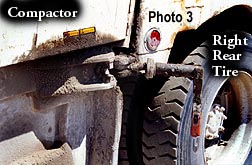 The sanitation truck
owner provided verbal instruction on precautions to be followed
during garbage unloading. The operator stated that both employees
were aware of the verbal notification to "stand clear"
when the hydraulic compactor was lowered. They were also aware
that the operator was responsible for operating the hydraulic
controls located on the driver's side of the cab, which included
securing the hydraulic compactor attachment screw (see Photo 3).
The sanitation truck
owner provided verbal instruction on precautions to be followed
during garbage unloading. The operator stated that both employees
were aware of the verbal notification to "stand clear"
when the hydraulic compactor was lowered. They were also aware
that the operator was responsible for operating the hydraulic
controls located on the driver's side of the cab, which included
securing the hydraulic compactor attachment screw (see Photo 3).
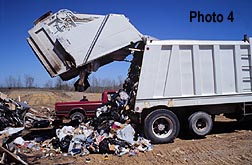 The garbage truck
unloaded at the landfill around 2-3 times per week. The shift
started at 7:30 am, and the owner and assistant collected garbage
at designated locations. On this occasion, the owner drove the
sanitation truck to the county landfill, with the assistant in
the passenger's seat. When they came to the unloading zone at
the landfill, the operator backed the truck into the designated
space for unloading. The operator and assistant then left the
cab and went to the back of the truck where each man unsecured
the attachment for the tailgate/compactor. Since the hydraulic
controls are outside the cab on the driver's side, the operator
is the only employee that operates the controls. The operator
raised the compactor to the upright position, (see Photo 4) emptying
its contents onto the ground.
The garbage truck
unloaded at the landfill around 2-3 times per week. The shift
started at 7:30 am, and the owner and assistant collected garbage
at designated locations. On this occasion, the owner drove the
sanitation truck to the county landfill, with the assistant in
the passenger's seat. When they came to the unloading zone at
the landfill, the operator backed the truck into the designated
space for unloading. The operator and assistant then left the
cab and went to the back of the truck where each man unsecured
the attachment for the tailgate/compactor. Since the hydraulic
controls are outside the cab on the driver's side, the operator
is the only employee that operates the controls. The operator
raised the compactor to the upright position, (see Photo 4) emptying
its contents onto the ground.
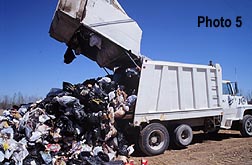 There is an internal
plate, which remains in a vertical position at the front of the
truck. This plate then moves to the rear pushing compacted garbage
out of the truck (see Photo 5). The bottom of this blade was slightly
damaged so there was a small amount of debris that remained on
the truck floor.
There is an internal
plate, which remains in a vertical position at the front of the
truck. This plate then moves to the rear pushing compacted garbage
out of the truck (see Photo 5). The bottom of this blade was slightly
damaged so there was a small amount of debris that remained on
the truck floor.
The operator then moved the truck forward several feet, and lowered the hydraulic compactor to the 3/4 position (see Photo 6). He returned to the rear of the truck on the driver's side. There is an attachment link on both sides of the truck that must be cleaned to ensure that the compactor will close and latch properly. The operator cleaned the link on the driver's side and the assistant cleaned the link on the passenger's side. With the compactor in the 3/4 position there is a clear line of sight between the two employees, and the operator looked at the assistant and shouted to the assistant to "stand clear". The assistant signaled a response.
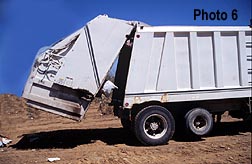 The operator noted
that the assistant was standing in the proper position, approximately
1.5 feet from the truck. At this point the operator walked to
the controls on the driver's side of the truck behind the cab
and lowered the compactor, which takes about six seconds. The
operator then secured the screw attachment link on his side of
the truck and went around the front of the truck to make sure
the attachment link on the passengers side was secure, according
to their routine.
The operator noted
that the assistant was standing in the proper position, approximately
1.5 feet from the truck. At this point the operator walked to
the controls on the driver's side of the truck behind the cab
and lowered the compactor, which takes about six seconds. The
operator then secured the screw attachment link on his side of
the truck and went around the front of the truck to make sure
the attachment link on the passengers side was secure, according
to their routine.
As the operator came around the front of the truck he saw the assistant lying on the ground, bleeding from the head. The operator called to a Caterpillar driver, the only other worker at the dumpsite, for help. The Caterpillar driver drove to the scales and called 911 for an ambulance. The County Deputy and ambulance personnel arrived at the scene at 11:06 am. Within a short time the county medical examiner was notified, responded and pronounced the man dead at the scene.
The County Deputy inspected the area and called the Sheriff for assistance. He gave the garbage truck operator a preliminary breath test for alcohol at 11:43 am, with a result of 0.00 reading for alcohol. When the sheriff reviewed the incident, he noticed a small object that remained on the floor of the garbage truck. After the truck was moved into a position where the sunlight shone into the garbage compartment, it was noted that the object was a fishing pole. Possibly the assistant saw the fishing pole as the compactor started to lower, and attempted to grab the pole. The truck operator mentioned that the two had been talking about fishing later that day, and it is likely the victim attempted to quickly grab the discarded fishing pole when his head was caught and crushed.
The Caterpillar driver stated he was standing on the driver's side of the truck waiting for the unloading to be complete, and did not see the incident happen.
CAUSE OF DEATH
The victim's head was pinched between the frame of the compactor and the rear frame of the truck. When he fell to the ground, his head was pulled free from the closing compactor.
RECOMMENDATIONS / DISCUSSION
RECOMMENDATION #1: Safety work practices should be re-emphasized with all employees, and in particular, with part-time employees.
Discussion: In this situation, verbal instruction was provided on the unloading process, and a sign was posted on the passenger's side of the truck to confirm this. It stated, "Stand clear when tailgate is in motion and during unloading cycle". In addition, employees should be reminded of the importance of safe work practices and the consequences of using hydraulic equipment. During our investigation, while the hydraulic compactor was moving, we instinctively stood clear of the truck, aware that the heavy hydraulic components could cause serious injury.
RECOMMENDATION #2: Employers should ensure that a job safety analysis has been performed on all work-related tasks.
Discussion: Job safety analysis (JSA) is a procedure used to review methods or steps for a particular task in order to identify potential hazards. The task can be broken down to a sequence of steps or actions, which are used to identify hazards connected to the task or produced by the environment. Once the hazards are known, the proper solutions can be developed to eliminate or control hazards. In this case, a job safety analysis may have identified the hazard of removing objects from the truck while the hydraulic compactor was partially raised or while it was being lowered.
| Lois Etre PhD. | Wayne Johnson M.D. |
| Industrial Hygienist/Investigator | Chief Trauma Investigator |
| Institute for Rural & Environmental Health | Institute for Rural & Environmental Health |
| The University of Iowa - Iowa City, Iowa | The University of Iowa - Iowa City, Iowa |
